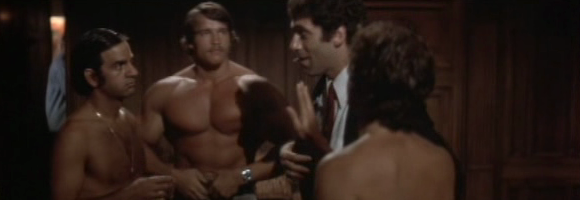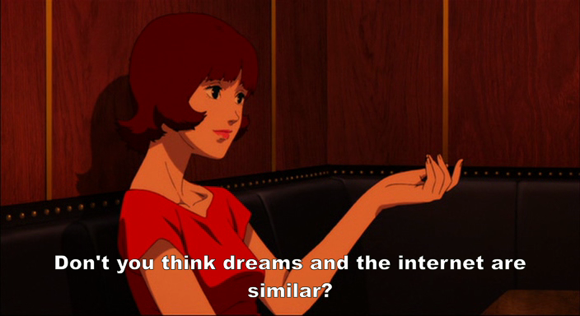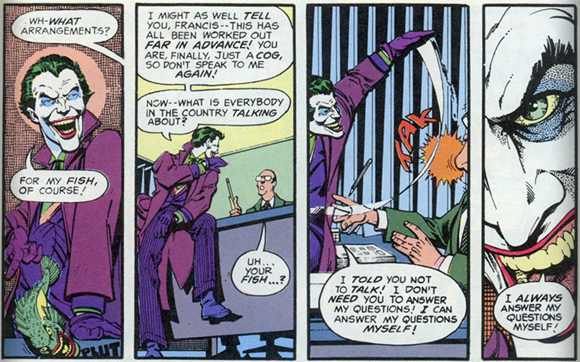zeph’s pop culture quiz #4

All right, everybody recognizes him standing in the background. But who wrote the novel the movie is based on? The movie is an unusual adaptation, because the other novels of the series were adapted to the silver screen decades earlier, with iconic actors almost defining a genre.
UPDATE and solution (26 November 2011):
My apologies for updating so late. Especially as ↵klandestino already solved the riddle, and provided a ↑YouTube link as proof, the day it was posted: In the background it of course is Arnold Schwarzenegger (not appearing in the movie’s credits), the guy with the tie is actor Elliott Gould playing shamus ↑Philip Marlowe in the movie ‘↑The Long Goodbye‘ directed by Robert Altman (1973), and based on the novel ‘↑The Long Good-Bye‘ written by ↑Raymond Chandler (1953). The screenplay for the Altman-movie was not written by Sterling Silliphant—he wrote the screenplay for another neo-noir Chandler-adaptation: ‘↑Marlowe‘ (Bogart 1969)—as klandestino suggested, but by ↑Leigh Brackett. She created the screenplays to quite a bunch of famous movies. Astoundingly enough, together with William Faulkner and Jules Furthman, she wrote the screenplay for ‘The Big Sleep’ (Hawks 1946), the classic movie adaptation of Chandler’s debut novel of the same name (1939).

Humphrey Bogart as Philip Marlowe and Lauren Bacall as Vivian Rutledge in 'The Big Sleep,' directed by Howard Hawks (1946)
Although not the first movie based on one of Chandler’s Marlowe novels, ‘The Big Sleep’ is seminal for the film noir genre. Starring Humphrey Bogart and Lauren Bacall, it also gave the genre iconic actors.
All six novels by Chandler (1939, 1940, 1942, 1943, 1949, 1953, 1958) and ‘Poodle Springs’ (a fragment left by Chandler and posthumously completed by Robert B. Parker—Chandler & Parker 1989 [1958]) feature private-eye Philip Marlowe. Meanwhile the whole lot (I read them all earlier this year :-) has been adapted to movies, some more than once: ‘The High Window’ (Chandler 1942) has been made into ‘Time to Kill’ (Leeds 1942) and ‘The Brasher Doubloon’ (Brahm 1947); ‘Farewell, My Lovely’ (Chandler 1940) into ‘The Falcon Takes Over’ (Reis 1942), ‘Murder, My Sweet’ (Dmytryk 1944), and ‘Farewell, My Lovely’ (Richards 1975); ‘The Big Sleep’ (Chandler 1939) under the same name into Hawks 1946 and Winner 1978; ‘The Lady in the Lake’ (Chandler 1944) into ‘Lady in the Lake’ (Montgomery 1947); ‘The Little Sister’ (Chandler 1949) into ‘Marlowe’ (Bogart 1969); ‘The Long Good-Bye’ (Chandler 1953) into ‘The Long Goodbye’ (Altman 1973); and finally ‘Poodle Springs’ (Chandler & Parker 1989 [1958]) under the same name into Rafelson 1998.
In consequence over time Marlowe has been played by many actors, some of them belonging to the greats. In chronological order: Lloyd Nolan, George Sanders, Dick Powell, Humphrey Bogart, George Montgomery, Robert Montgomery, James Garner, Elliott Gould, Robert Mitchum (twice), and James Caan.
Nevertheless Bogart stuck as an icon until today.
Chandler’s Marlowe owes much to Dashiell Hammett’s character of the same profession: Sam Spade. When ‘The Maltese Falcon’ (Hammett 1930) was adapted to the big screen for the third time (Huston 1941), the choice already was Bogart. Huston’s movie became one of the all time classics, the earlier two versions (Del Ruth 1931, Dieterle 1936) almost forgotten.

'The Maltese Falcon' (Huston 1941) and Humphrey Bogart as Sam Spade
BOGART, PAUL. 1969. Marlowe [motion picture]. Century City: Metro-Goldwyn-Mayer.
BRAHM, JOHN. 1947. The Brasher doubloon [motion picture]. Century City: 20th Century Fox.
CHANDLER, RAYMOND THORNTON. 1939. The big sleep. New York: Alfred A. Knopf.
CHANDLER, RAYMOND THORNTON. 1940. Farewell, my lovely. New York: Alfred A. Knopf.
CHANDLER, RAYMOND THORNTON. 1942. The high window. New York: Alfred A. Knopf.
CHANDLER, RAYMOND THORNTON. 1943. The lady in the lake. New York: Alfred A. Knopf.
CHANDLER, RAYMOND THORNTON. 1949. The little sister. Boston: Houghton Mifflin.
CHANDLER, RAYMOND THORNTON. 1953. The long good-bye. London: Hamish Hamilton.
CHANDLER, RAYMOND THORNTON. 1958. Playback. Boston: Houghton Mifflin.
CHANDLER, RAYMOND THORNTON AND ROBERT BROWN PARKER. 1989 [1958]. Poodle springs. New York: G. P. Putnam’s Sons.
DEL RUTH, ROY. 1931. The Maltese falcon [motion picture]. Burbank: Warner Bros.
DIETERLE, WILLIAM. 1936. Satan met a lady [motion picture]. Burbank: Warner Bros.
DMYTRYK, EDWARD. 1944. Murder, my sweet [motion picture]. New York: RKO Radio Pictures.
HAMMETT, SAMUEL DASHIELL. 1930. The Maltese falcon. New York: Alfred A. Knopf.
HAWKS, HOWARD WINCHESTER. 1946. The big sleep [motion picture]. Burbank: Warner Bros.
HUSTON, JOHN MARCELLUS. 1941. The Maltese falcon [motion picture]. Burbank: Warner Bros.
LEEDS, HERBERT I. 1942. Time to kill [motion picture]. Century City: 20th Century Fox.
MONTGOMERY, ROBERT. 1947. Lady in the lake [motion picture]. Century City: Warner Bros.
RAFELSON, ROBERT ‘BOB’. 1998. Poodle springs [motion picture]. New York: HBO.
REIS, IRVING. 1942. The falcon takes over [motion picture]. New York: RKO Radio Pictures.
RICHARDS, DICK. 1975. Farewell, my lovely [motion picture]. ?: Avco Embassy Pictures.
WINNER, MICHAEL ROBERT. 1978. The big sleep [motion picture]. Los Angeles: United Artists.















